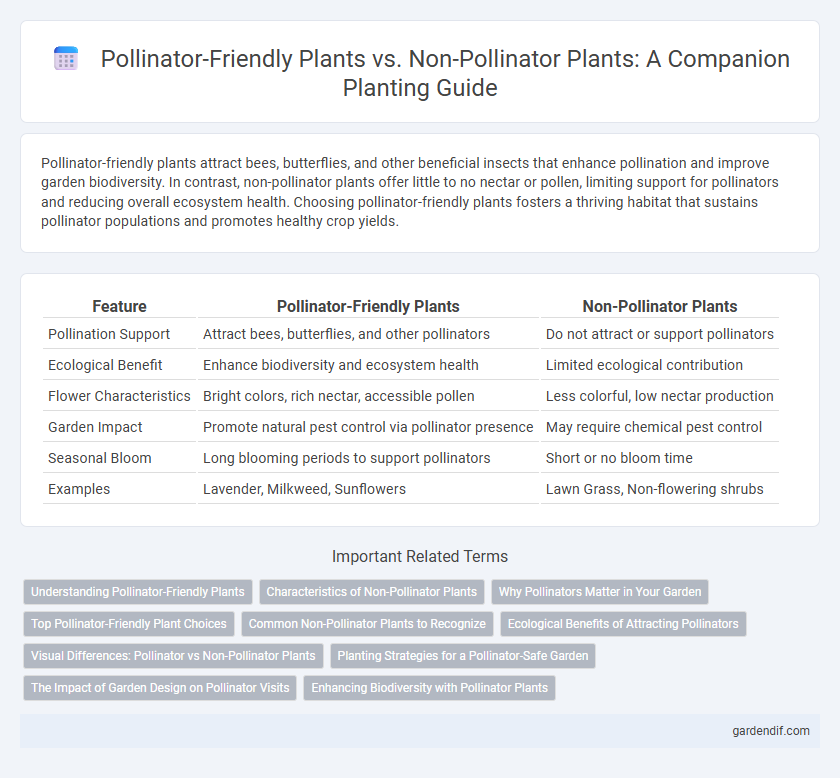
Pollinator-friendly plants vs non-pollinator plants Illustration
Pollinator-friendly plants attract bees, butterflies, and other beneficial insects that enhance pollination and improve garden biodiversity. In contrast, non-pollinator plants offer little to no nectar or pollen, limiting support for pollinators and reducing overall ecosystem health. Choosing pollinator-friendly plants fosters a thriving habitat that sustains pollinator populations and promotes healthy crop yields.
Table of Comparison
| Feature | Pollinator-Friendly Plants | Non-Pollinator Plants |
|---|---|---|
| Pollination Support | Attract bees, butterflies, and other pollinators | Do not attract or support pollinators |
| Ecological Benefit | Enhance biodiversity and ecosystem health | Limited ecological contribution |
| Flower Characteristics | Bright colors, rich nectar, accessible pollen | Less colorful, low nectar production |
| Garden Impact | Promote natural pest control via pollinator presence | May require chemical pest control |
| Seasonal Bloom | Long blooming periods to support pollinators | Short or no bloom time |
| Examples | Lavender, Milkweed, Sunflowers | Lawn Grass, Non-flowering shrubs |
Understanding Pollinator-Friendly Plants
Pollinator-friendly plants provide essential nectar and pollen resources that attract bees, butterflies, and other pollinators, supporting biodiversity and ecosystem health. These plants often feature bright colors, UV patterns, and accessible floral structures that facilitate pollinator access, unlike non-pollinator plants which may lack these adaptive traits. Incorporating pollinator-friendly species such as lavender, milkweed, and coneflowers enhances pollination efficiency and promotes sustainable gardening practices.
Characteristics of Non-Pollinator Plants
Non-pollinator plants typically lack vibrant colors, nectar, and strong fragrances, making them less attractive to pollinators like bees and butterflies. These plants often rely on wind or self-pollination, exhibiting traits such as reduced or absent petals and lightweight pollen grains adapted for dispersal without animal assistance. Understanding these characteristics helps gardeners select companion plants that either support pollinator activity or serve specific ecosystem roles without attracting pollinators.
Why Pollinators Matter in Your Garden
Pollinator-friendly plants enhance biodiversity by attracting essential pollinators like bees, butterflies, and hummingbirds, which increase fruit and seed production in gardens. Non-pollinator plants lack the nectar and pollen resources that support these vital insects, resulting in reduced plant reproduction and weakened ecosystems. Incorporating pollinator-friendly plants directly supports healthy pollinator populations, sustaining ecological balance and improving crop yields.
Top Pollinator-Friendly Plant Choices
Top pollinator-friendly plants such as lavender, milkweed, and coneflowers provide essential nectar and habitat for bees, butterflies, and hummingbirds, supporting biodiversity and ecosystem health. These plants attract a wide variety of pollinators compared to non-pollinator plants, which lack nectar or pollen resources, reducing insect activity and pollination rates. Incorporating native, nectar-rich species in gardens or landscapes enhances pollinator populations and promotes sustainable companion planting practices.
Common Non-Pollinator Plants to Recognize
Common non-pollinator plants such as ferns, mahonia, and certain varieties of ivy typically lack nectar and pollen, making them less attractive to bees, butterflies, and other pollinators crucial for ecological balance. These plants often rely on wind or self-pollination and do not contribute directly to pollinator food webs. Recognizing non-pollinator plants is essential for gardeners aiming to create pollinator-friendly environments that support biodiversity and healthy ecosystems.
Ecological Benefits of Attracting Pollinators
Pollinator-friendly plants such as lavender, coneflowers, and milkweed support ecosystems by attracting bees, butterflies, and hummingbirds, essential for pollination and biodiversity. These plants enhance soil health, improve crop yields, and maintain genetic diversity by facilitating cross-pollination. In contrast, non-pollinator plants provide limited ecological benefits and often fail to support the survival of key pollinator species within garden and agricultural environments.
Visual Differences: Pollinator vs Non-Pollinator Plants
Pollinator-friendly plants typically exhibit vibrant colors such as bright reds, yellows, and purples that attract bees, butterflies, and hummingbirds, while non-pollinator plants often display muted or less varied hues. The flowers of pollinator plants tend to have open shapes or tubular structures with accessible nectar guides, contrasting with non-pollinator plants that usually have closed or dense blooms. Leaf texture and plant architecture also differ, as pollinator plants often feature softer, more inviting foliage compared to the tougher, less appealing textures found in non-pollinator varieties.
Planting Strategies for a Pollinator-Safe Garden
Planting pollinator-friendly plants such as milkweed, lavender, and coneflowers enhances garden biodiversity and supports essential pollinator populations like bees, butterflies, and hummingbirds. Strategically intersperse these species with non-pollinator plants like ornamental grasses or native ferns to create habitat diversity and reduce pest issues without compromising pollinator activity. Utilizing layered planting, continuous bloom sequences, and avoiding pesticides are key strategies to establish a pollinator-safe garden that sustains healthy ecosystems.
The Impact of Garden Design on Pollinator Visits
Pollinator-friendly plants such as lavender, milkweed, and coneflowers significantly increase pollinator visits compared to non-pollinator plants like boxwood or ornamental grasses, which offer little to no nectar or pollen. Garden design that clusters diverse pollinator-attracting species in sunny, sheltered areas encourages greater pollinator activity and supports biodiversity. Incorporating native flowering plants with staggered bloom times maximizes continuous food sources, enhancing habitat quality for bees, butterflies, and other key pollinators.
Enhancing Biodiversity with Pollinator Plants
Pollinator-friendly plants such as milkweed, coneflowers, and bee balm significantly enhance biodiversity by attracting essential pollinators like bees, butterflies, and hummingbirds. These plants support ecosystem health by providing nectar and pollen, which sustain pollinator populations crucial for crop production and wild plant reproduction. In contrast, non-pollinator plants often lack nectar resources, reducing habitat quality and limiting pollinator presence, thereby diminishing overall biodiversity.
Pollinator-friendly plants vs non-pollinator plants Infographic

 gardendif.com
gardendif.com